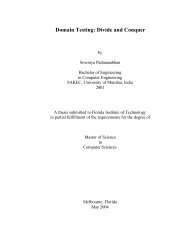appendix 1. analyzing the triangle problem - Testing Education
appendix 1. analyzing the triangle problem - Testing Education
appendix 1. analyzing the triangle problem - Testing Education
You also want an ePaper? Increase the reach of your titles
YUMPU automatically turns print PDFs into web optimized ePapers that Google loves.
ANALYZING THE TRIANGLE PROBLEM<br />
“No book on software testing is complete without a discussion of <strong>the</strong> <strong>triangle</strong> <strong>problem</strong>.” Ed Kit.<br />
(This is meant as a joke, because this <strong>problem</strong> has been thoroughly worked and re-worked over<br />
<strong>the</strong> years. Never<strong>the</strong>less, this <strong>problem</strong> still retains its educational value.)<br />
At least six self-proclaimed experts have developed answers for <strong>the</strong> <strong>triangle</strong> <strong>problem</strong> (including<br />
this self-proclaimed expert, <strong>the</strong> author), and each answer is different. When experts do not agree<br />
on <strong>the</strong> answer to a seemingly simple <strong>problem</strong>, perhaps this tells us something about <strong>the</strong> state of<br />
<strong>the</strong> art of testing.<br />
The <strong>triangle</strong> <strong>problem</strong> was mentioned in Chapter III. Using intuitive, off-<strong>the</strong>-cuff techniques,<br />
systems professionals were able to identify only about half <strong>the</strong> test cases for <strong>the</strong> <strong>triangle</strong> <strong>problem</strong>.<br />
This <strong>problem</strong> provides an opportunity to see how <strong>the</strong> functional analysis, path analysis, boundary<br />
value and risk assessment methods can be applied.<br />
Re-Statement of <strong>the</strong> Problem<br />
Develop a set of test cases to adequately test a program, which works as follows:<br />
The program reads three input numbers that represent <strong>the</strong> lengths of <strong>the</strong> three sides of a<br />
<strong>triangle</strong>.<br />
Based on <strong>the</strong>se three input values, <strong>the</strong> program determines whe<strong>the</strong>r <strong>the</strong> <strong>triangle</strong> is scalene<br />
(that is, it has three unequal sides), isosceles (two equal sides), or equilateral (three equal<br />
sides).<br />
The program displays <strong>the</strong> result on <strong>the</strong> screen.<br />
Glen Meyers originally described this <strong>problem</strong> in his book, “The Art of Software <strong>Testing</strong>”.<br />
Exercise (Allow 15 to 20 minutes for this exercise.)<br />
There is no one correct <strong>the</strong>oretical answer to any testing <strong>problem</strong>. The answer depends on <strong>the</strong><br />
assumptions and judgement calls which <strong>the</strong> test planner makes.<br />
Review and critique <strong>the</strong> following set of test cases for <strong>the</strong> <strong>triangle</strong> <strong>problem</strong>. How do you suggest<br />
that we improve <strong>the</strong>m?<br />
Copyright 2004 Collard 2 & Company<br />
Appendix 1<br />
2








